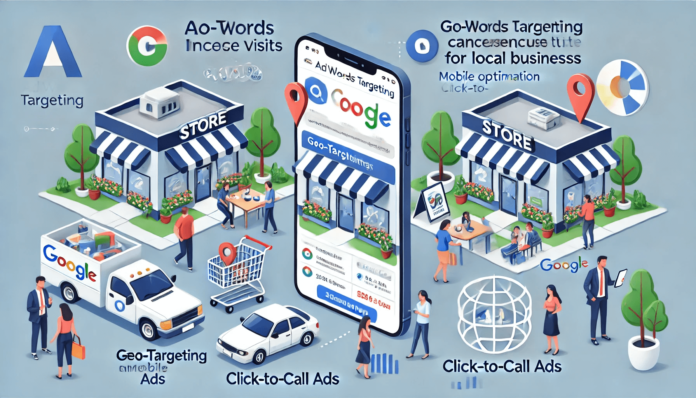Introduction
- Why Google AdWords is Essential for Local Businesses
- Set Up Location Targeting for Local Reach
- Use Local Keywords to Attract Nearby Shoppers
- Optimize Your Ad Copy for Local Appeal
- Leverage Google My Business Integration
- Run Mobile-Optimized Campaigns for On-the-Go Shoppers
- Utilize AdWords Reporting to Track Store Visits
- Retarget Local Shoppers with Display Ads
- AdWords Targeting Strategies to Boost Local Store Traffic
- Conclusion
Using effective AdWords targeting strategies is a powerful way to increase store visits with PPC and attract local customers with ads tailored to their needs. By leveraging Google Ads’ advanced location targeting, keyword optimization, and mobile-friendly campaigns, businesses can connect with potential customers actively searching for their products or services. Whether you’re aiming to boost foot traffic or drive online inquiries that convert to in-store visits, the right AdWords tactics can help maximize your marketing ROI and ensure your business stands out in local search results.
Why Google AdWords is Essential for Local Businesses
Google AdWords, now known as Google Ads, provides businesses with the ability to appear at the top of search engine results pages (SERPs) when potential customers search for relevant products or services in their area. Unlike traditional marketing methods, Google Ads offers precision targeting, allowing businesses to reach the right audience at the right time.
Key Benefits of Google Ads for Local Businesses:
- Immediate Visibility: Appears at the top of search results when local shoppers search for your offerings.
- Cost-Effective Marketing: Only pay when someone clicks your ad.
- Advanced Targeting: Reach potential customers based on their location, interests, and search intent.
- Trackable Performance: Measure store visits and optimize ad performance accordingly.
Set Up Location Targeting for Local Reach
One of the most powerful features of AdWords is geo-targeting, which allows businesses to show their ads to people in specific locations. To maximize store visits, it’s crucial to set up location targeting correctly.
How to Enable Location Targeting:
- Log into your Google Ads account and navigate to your campaign settings.
- Select the “Locations” tab and choose “Advanced Search.”
- Enter your store’s address and set a specific radius (e.g., 5-10 miles) to target local shoppers effectively.
- Exclude areas that are irrelevant to your business to prevent wasted ad spend.
Pro Tip:
Use Google’s location bid adjustment to increase bids for users within a certain radius of your store, ensuring your ads appear more prominently.
Use Local Keywords to Attract Nearby Shoppers
To make your ads more relevant, incorporate local keywords that customers commonly search for. Using terms such as “near me” or specific location-based phrases helps improve visibility and relevance.
Examples of Local Keywords:
- “Best bakery near me”
- “Affordable hair salon in [City Name]”
- “Plumbing services in [Neighborhood]”
- “Local grocery store near me”
Optimize Your Ad Copy for Local Appeal
Crafting compelling ad copy is crucial for driving store visits. Your ad should highlight key local elements such as proximity, promotions, and unique offerings.
Key Elements to Include in Ad Copy:
- Location Mention: Example – “Visit our store in Downtown [City Name]!”
- Special Offers: Example – “20% Off In-Store Purchase Today!”
- Call-to-Action (CTA): Example – “Get Directions Now!” or “Stop by Today!”
Leverage Google My Business Integration
Linking your Google My Business (GMB) account with your AdWords campaigns can significantly enhance your local presence. This integration allows your store information, reviews, and hours to appear in search results, making it easier for customers to find you.
How to Integrate GMB with AdWords:
- Go to your Google Ads dashboard and click “Extensions.”
- Select “Location Extensions” and connect your Google My Business profile.
- Ensure your store’s address, phone number, and hours are accurate.
Run Mobile-Optimized Campaigns for On-the-Go Shoppers
Since most local searches happen on mobile devices, optimizing your ads for mobile users can increase store visits significantly. Mobile users often look for quick solutions, so ensuring a seamless experience is key.
How to Optimize for Mobile:
- Use click-to-call ads to encourage immediate inquiries.
- Implement responsive landing pages with easy-to-read contact information.
- Utilize location-based push notifications for promotions.
Pro Tip:
Enable mobile bid adjustments to prioritize users searching on smartphones when they’re near your store.
Utilize AdWords Reporting to Track Store Visits
Google Ads provides insights into how well your campaigns are driving store visits. By analyzing this data, businesses can adjust their campaigns to optimize performance and maximize ROI.
Key Metrics to Track:
- Store Visit Conversions: Tracks the number of customers visiting your store after clicking your ad.
- Click-Through Rate (CTR): Measures how many users clicked your ad.
- Conversion Rate: Tracks how many clicks resulted in in-store visits.
- Cost-Per-Click (CPC): Measures the amount spent per visitor.
Pro Tip:
Use A/B testing to experiment with different ad variations and optimize based on performance.
Retarget Local Shoppers with Display Ads
Retargeting allows businesses to re-engage users who previously visited their website but didn’t convert. With Google Display Network, you can show ads to these potential customers across thousands of websites and encourage them to visit your store.
Effective Retargeting Strategies:
- Display personalized promotions based on browsing history.
- Use dynamic remarketing to show products the customer previously viewed.
- Create urgency with limited-time offers.
Pro Tip:
Offer exclusive in-store discounts to users who click on remarketing ads.
AdWords Targeting Strategies to Boost Local Store Traffic

Implementing the right AdWords targeting strategies is crucial for businesses looking to attract local customers and drive foot traffic. Google Ads provides a variety of targeting options that allow businesses to reach the right audience at the right time.
Key Targeting Strategies Include:
- Geo-Targeting: Focus your ads on specific locations, ensuring they appear only to users within a set radius of your store.
- Keyword Targeting: Use location-specific keywords such as “near me” searches to attract nearby shoppers.
- Device Targeting: Optimize ads for mobile users who are more likely to search for local businesses on the go.
- Ad Scheduling: Run ads during peak hours when potential customers are more likely to visit your store.
- Audience Segmentation: Target customers based on demographics, interests, and purchase behavior to maximize ad effectiveness.
By refining these strategies, businesses can enhance their online visibility, attract high-intent customers, and increase store visits efficiently.
Conclusion
Utilizing Google AdWords to target local shoppers is an invaluable strategy for increasing store visits and driving sales. By leveraging location targeting, optimizing ad copy, and tracking key metrics, local businesses can connect with their ideal audience and grow their customer base effectively.
Whether you’re looking to attract more foot traffic, boost brand awareness, or enhance local reach, a well-planned AdWords campaign can help you achieve your business goals. Start implementing these strategies today and watch your local store thrive in the digital landscape.














